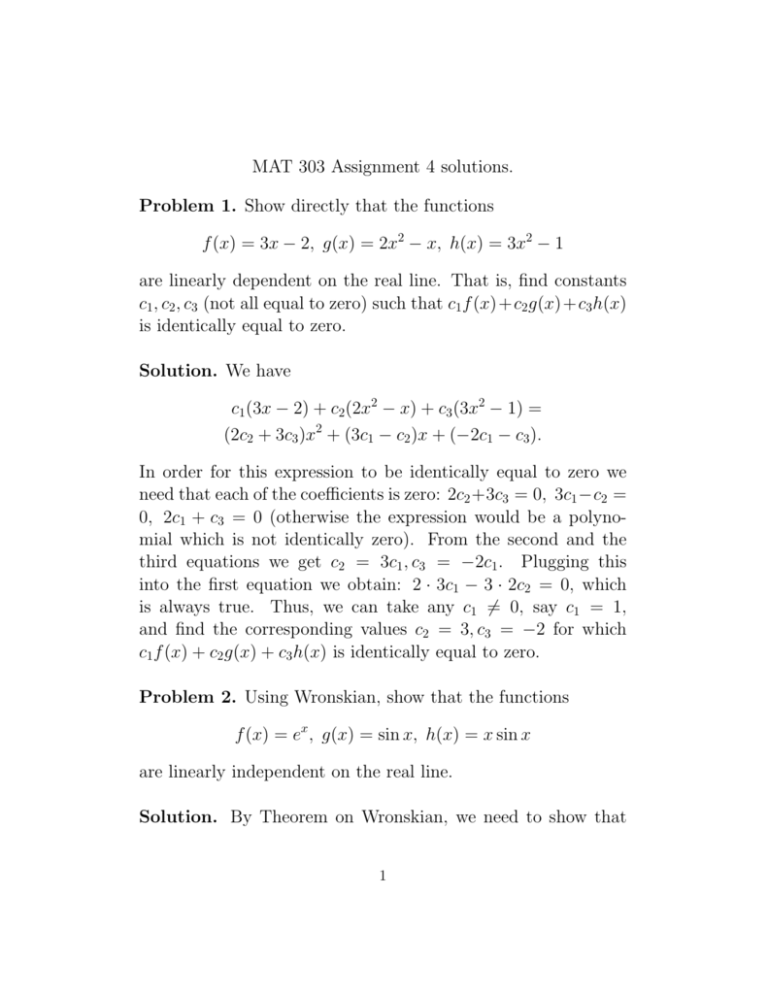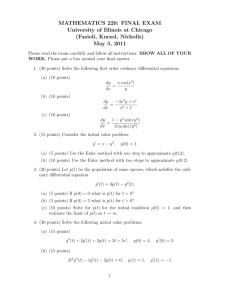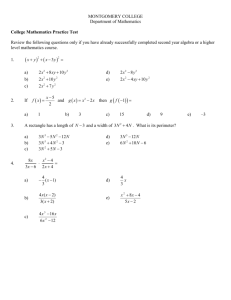MAT 303 Assignment 4 solutions. Problem 1. Show directly that the
advertisement

MAT 303 Assignment 4 solutions. Problem 1. Show directly that the functions f (x) = 3x − 2, g(x) = 2x2 − x, h(x) = 3x2 − 1 are linearly dependent on the real line. That is, find constants c1 , c2 , c3 (not all equal to zero) such that c1 f (x)+c2 g(x)+c3 h(x) is identically equal to zero. Solution. We have c1 (3x − 2) + c2 (2x2 − x) + c3 (3x2 − 1) = (2c2 + 3c3 )x2 + (3c1 − c2 )x + (−2c1 − c3 ). In order for this expression to be identically equal to zero we need that each of the coefficients is zero: 2c2 +3c3 = 0, 3c1 −c2 = 0, 2c1 + c3 = 0 (otherwise the expression would be a polynomial which is not identically zero). From the second and the third equations we get c2 = 3c1 , c3 = −2c1 . Plugging this into the first equation we obtain: 2 · 3c1 − 3 · 2c2 = 0, which is always true. Thus, we can take any c1 6= 0, say c1 = 1, and find the corresponding values c2 = 3, c3 = −2 for which c1 f (x) + c2 g(x) + c3 h(x) is identically equal to zero. Problem 2. Using Wronskian, show that the functions f (x) = ex , g(x) = sin x, h(x) = x sin x are linearly independent on the real line. Solution. By Theorem on Wronskian, we need to show that 1 W (x) is not identically equal to 0, that is, there exists x0 for which W (x0 ) 6= 0. We have: x e sin x x sin x W (x) = ex cos x x cos x + sin x ex − sin x −x sin x + 2 cos x. Guess a point x0 for which W (x0 ) 6= 0. Take x0 = 0. We 1 W (0) = 1 1 W (x0 ) is easy to calculate and have: 0 0 1 0 = 2 6= 0. 0 2 Therefor, the functions are linearly independent. Problem 3. 1) Verify that the functions y1 = 1, y2 = x3 , y3 = ln x are solutions of the differential equation x2 y (3) − 2y 0 = 0. 2) Show that y1 , y2 , y3 are linearly independent. 3) Solve the initial value problem y(1) = 2, y 0 (1) = 2, y 00 (1) = 7. (3) (3) Solution. 1) One has: y10 = y1 = 0, y20 = 3x2 , y2 = 6, y30 = (3) 1 , y = x23 . Plugging each of the functions y1 , y2 , y3 into the 3 x equation we obtain 0. Therefor, they are solutions. 2) To verify linear independence let us calculate the Wronskian: 1 x3 ln x 1 1 0 W (x) = 0 3x2 x1 , W (1) = 0 3 1 = −9 6= 0. 0 6x − x12 0 6 −1 2 By Theorem on Wronskian, the functions are linearly independent. 3) By Principle of Superposition, the general solution is of the form: y(x) = c1 y1 + c2 y2 + c3 y3 = c1 + c2 x3 + c3 ln x. Plugging the initial conditions we obtain: c1 + c2 = 2, 3c2 + c3 = 2, 6c2 − c3 = 7. Solving this system, we find: c1 = 1, c2 = 1, c3 = −1. Thus, y(x) = 1 + x3 − ln x. Problem 4. Find the general solution of the differential equation y (4) − 23 y 00 + 12 y = 0. Solution. First, let us solve the characteristic equation: r4 − 1 3 2 2 r + 2 = 0. If we set s = r we obtain a quadratic equation: s2 − 23 s + 12 = 0. Its solutions are: s1 = −1, s2 = 12 . Now we can find r by solving: r2 = −1 ⇒ r1,2 = ±i and r2 = 21 ⇒ r3,4 = ± √12 . The complex roots ±i give solutions y1 = cos x, y2 = sin x. The real roots solution is: ± √12 give solutions y3,4 = y(x) = c1 cos x + c2 sin x + c3 x ±√ e 2. x −√ e 2 Thus, the general + c4 √x e 2. Problem 5. Assume that a homogeneous differential equation with constant coefficients has the characteristic equation of the form (2r − 3)(r − 1)2 (r + 2)2 = 0. 3 Using polynomial differential operators show that y = xe−2x is a particular solution of this differential equation. Solution. A homogeneous differential equation with constant coefficient with the characteristic polynomial p(r) can be written as p(D)y = 0. Thus, the equation described in the problem can be written in terms of the polynomial differential operator as follows: (2D − 3)(D − 1)2 (D + 2)2 y = 0. For y = xe−2x we have: (D+2)y = y 0 +2y = e−2x , (D+2)2 y = (D+2)(e−2x ) = (e−2x )0 +2e−2x = 0. Therefor, (2D − 3)(D − 1)2 (D + 2)2 y = (2D − 3)(D − 1)2 0 = 0, which shows that y is a solution. Problem 6. Solve the initial value problem y 00 + 2y 0 + 5y = 0, y(π) = 0, y 0 (π) = 1. Solution. First, solve the characteristic equation: r2 + 2r + 5 = 0. We have: r1,2 = −1 ± 2i. Therefor, the general solution is: y(x) = e−x (c1 cos 2x + c2 sin 2x). To find c1 , c2 plug the initial conditions. We have, y 0 (x) = e−x ((−c1 + 2c2 ) cos 2x − (2c1 + c2 ) sin 2x). Thus, 0 = y(π) = e−π c1 ⇒ c1 = 0, 1 = e−π (−c1 + 2c2 ) ⇒ c2 = The answer is y(x) = eπ −x sin 2x. 2e 4 eπ 2. Problem 7. Assume that the roots of a characteristic polynomial of a homogeneous differential equation with constant coefficients are: 0, 0, 0, 1, 1 + 3i, 1 − 3i, 5. Write the general solution of this differential equation. Answer: y(x) = c1 +c2 x+c3 x2 +c4 ex +ex (c5 cos 3x+c6 sin 3x)+ c7 e5x . 5







